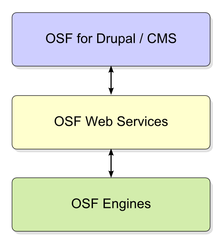Open Semantic Framework
A major contributor to this article appears to have a close connection with its subject. (December 2014) |
 | |
| Developer(s) | Structured Dynamics |
|---|---|
| Initial release | June 2009 |
| Stable release | OSF v 3.4
/ March 2016 |
| Repository | |
| Written in | |
| Operating system | platform independent |
| Type | |
Apache 2 | |
| Website | opensemanticframework |
The Open Semantic Framework (OSF) is an integrated
OSF is a platform-independent
The
Some of the use applications for OSF include
or any domain that may be modeled by ontologies.Documentation and training videos are provided with the open-source OSF application.
History
Early components of OSF were provided under the names of structWSF and conStruct starting in June 2009.[7] The first version 1.x of OSF was announced in August 2010. The first automated OSF installer was released in March 2012.[8] OSF was expanded with an ontology manager, structOntology in August 2012.[9] The version 2.x developments of OSF occurred for enterprise sponsors in the period of early 2012 until the end of 2013. None of these interim 2.x versions were released to the public. Then, at the conclusion of this period, Structured Dynamics, the main developer of OSF, refactored these specific enterprise developments to leapfrog to a new version 3.0 of OSF, announced in early 2014.[10] These public releases were last updated to OSF version 3.4.0 in August 2016.[11]
Architecture and technologies

The Open Semantic Framework has a basic three-layer architecture. User interactions and content management are provided by an external
The premise of the OSF stack is based on the RDF data model. RDF provides the means for integrating existing structured data assets in any format, with semi-structured data like XML and HTML, and unstructured documents or text. The OSF framework is made operational via ontologies that capture the domain or knowledge space, matched with internal ontologies that guide OSF operations and data display. This design approach is known as ODapps, for ontology-driven applications.[1]
Content management layer
OSF delegates all direct user interactions and standard content management to an external CMS. In the case of Drupal, this integration is tighter,[12] and supports connectors and modules that can replace standard Drupal storage and databases with OSF triplestores.[13]
Web services layer
This intermediate OSF Web Services layer may also be accessed directly via API or command line or utilities like cURL, suitable for interfacing with standard content management systems (CMSs), or via a dedicated suite of connectors and modules that leverage the open source Drupal CMS. These connectors and modules, also part of the standard OSF stack and called OSF for Drupal, natively enable Drupal's existing thousands of modules and ecosystem of developers and capabilities to access OSF using familiar Drupal methods.[12]
The OSF middleware framework is generally
Engines layer
The engines layer represents the major workflow requirements and data management and indexing of the system. The premise of the Open Semantic Framework is based on the RDF data model. Using a common data model means that all Web services and actions against the data only need to be programmed via a single, canonical form. Simple converters convert external, native data formats to the RDF form at time of ingest; similar converters can translate the internal RDF form back into native forms for export (or use by external applications). This use of a canonical form leads to a simpler design at the core of the stack and a uniform basis to which tools or other work activities can be written.[original research?]
The OSF engines are all open source and work to support this premise. The OSF engines layer governs the index and management of all OSF content. Documents are indexed by the
Alternatives
OSF is sometimes referred to as a linked data application.[18] Alternative applications in this space include:
The Open Semantic Framework also has alternatives in the semantic publishing and semantic computing arenas.
See also
- Data integration
- Data management
- Drupal
- Enterprise information integration
- Knowledge organization
- Linked data
- Middleware
- Ontology-based data integration
- Resource Description Framework
- Resource-oriented architecture
- Semantic computing
- Semantic integration
- Semantic publishing
- Semantic search
- Semantic service-oriented architecture
- Semantic technology
- Software framework
- Web Ontology Language
References
- ^ a b Michael K. Bergman (13 March 2014). OSF: An ontology-driven semantic platform for enterprises (PDF). 2014 Ontology Summit, Track B "Tools, Services, Techniques".
- ^ Comments, Posted: 05/13/2013 1:12 PM | (23 May 2013). "New website profiles neighbourhoods of Winnipeg". Winnipeg Free Press. Retrieved 30 September 2014.
{{cite news}}: CS1 maint: numeric names: authors list (link) - ^ "HealthDirect Australia". Retrieved 30 September 2014.
- ^ United Way of Winnipeg (2012). "PEG". Retrieved 30 September 2014.
- ].
- ^ Steven Ardire (27–28 October 2010). Using an open source semantic framework to create meaningful, interoperable information for better citizen engagement. The Government Open Source Conference, GOSCON 2010. Portland, Oregon: Oregon State University.
- ^ "Structured data and web services framework for Drupal unveiled". Structured Dynamics. 16 June 2009. Retrieved 30 September 2014.
- ^ Angela Guess (5 March 2012). "Open Semantic Framework installer released". SemanticWeb.com. Retrieved 30 September 2014.
- ^ Angela Guess (3 August 2012). "Inside UMBEL: structOntology". SemanticWeb.com. Retrieved 30 September 2014.
- ^ Angela Guess (21 January 2014). "SD unveils enterprise-ready version of the Open Semantic Framework". SemanticWeb.com. Retrieved 30 September 2014.
- ^ Frédérick Giasson (4 March 2016). "OSF 3.4 Released: now easily deployable in CentOS 6 and 7". fgiasson.com. Retrieved 4 March 2016.
- ^ a b "OSF for Drupal". 21 October 2013. Retrieved 30 September 2014.
- ^ Frédérick Giasson (10 June 2013). "structFieldStorage: A new field storage system for Drupal". fgiasson.com. Retrieved 30 September 2014.
- ISBN 978-1-84951-606-8.
- ^ OpenLink Software (11 April 2006). "Open source edition of OpenLink Virtuoso, unleashed!". Retrieved 3 February 2010.
- ^ Matthew Horridge & Sean Bechhofer (2011). "The OWL API: A Java API for OWL ontologies". Semantic Web. Vol. 2, no. 1. pp. 11-21.
- ^ H. Cunningham; D. Maynard; K. Bontcheva; V. Tablan (2002). GATE: A framework and graphical development environment for robust NLP tools and applications (PDF). Proceedings of the 40th Anniversary Meeting of the Association for Computational Linguistics, 2002.
- .
External links
- Official website
- Drupal
- GATE
- Open Semantic Framework code repository at GitHub
- OSF interest group
- OWL API
- Virtuoso
Further information
- Technical documentation library at the "OSF Technical Documentation Wiki". OSF Wiki. Retrieved 28 August 2015.
- Video training series at the "OSF Academy". YouTube Open Semantic Framework Academy. Retrieved 30 September 2014.
